Comprehensive Analysis of Primark's Business Environment Factors
VerifiedAdded on 2019/12/28
|16
|5249
|180
Report
AI Summary
This report offers a comprehensive analysis of Primark's business environment, examining both internal and external factors impacting its operations. It begins with an introduction to Primark, a UK-based retail subsidiary of Associated British Foods, detailing its product offerings and business purpose. The report then delves into stakeholder analysis, outlining the objectives of employees, suppliers, customers, financial institutions, and competitors. It further explores Primark's corporate social responsibilities towards its stakeholders, including legal and ethical considerations. The report also examines different economic systems, comparing command, mixed, and free market economies, with specific examples like Cuba, the UK, and China. It analyzes the impact of fiscal and monetary policies on the housing and farming sectors in the UK. Finally, the report discusses competition policies and their influence on Primark, concluding with a summary of the key findings and a list of references.
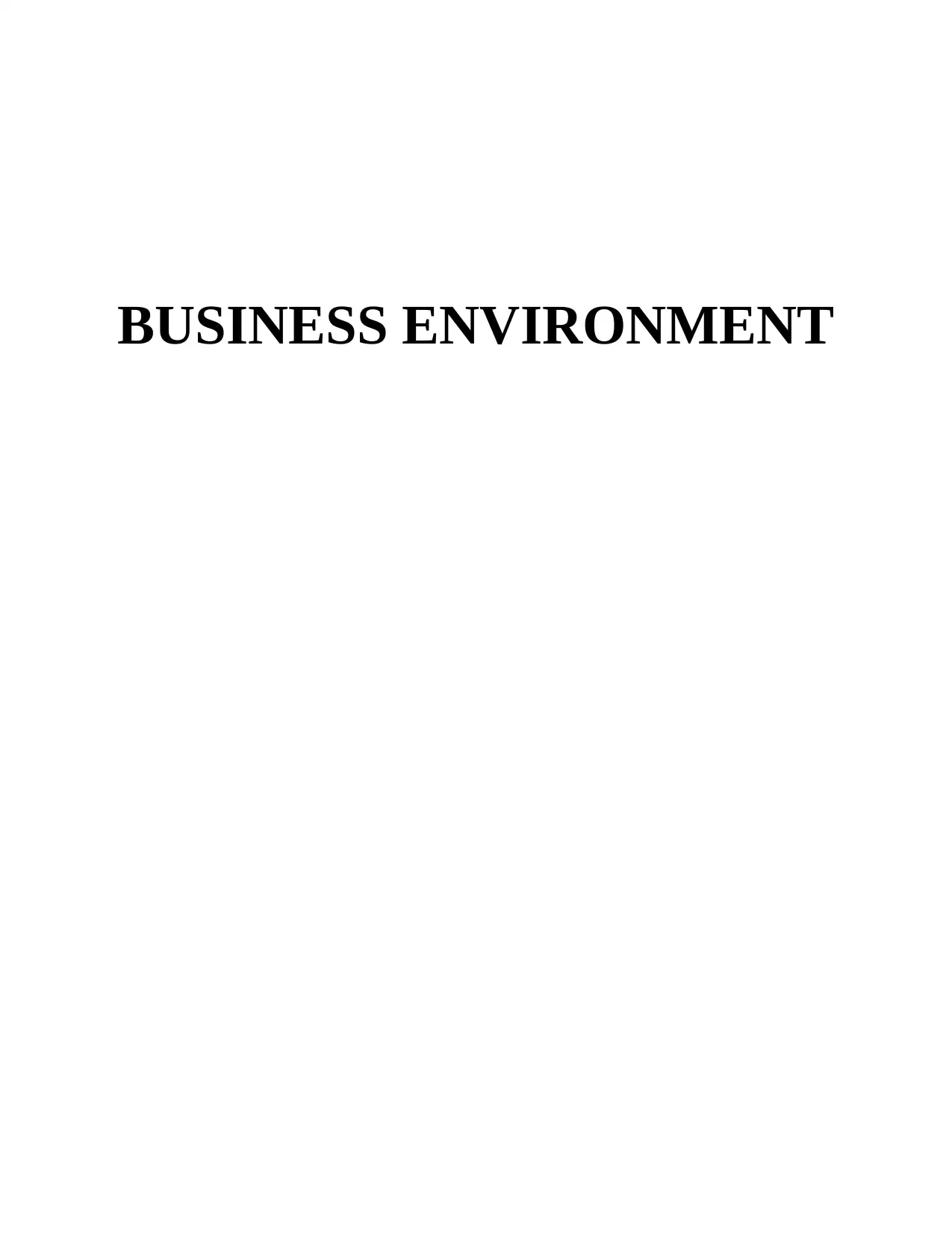
BUSINESS ENVIRONMENT
Paraphrase This Document
Need a fresh take? Get an instant paraphrase of this document with our AI Paraphraser
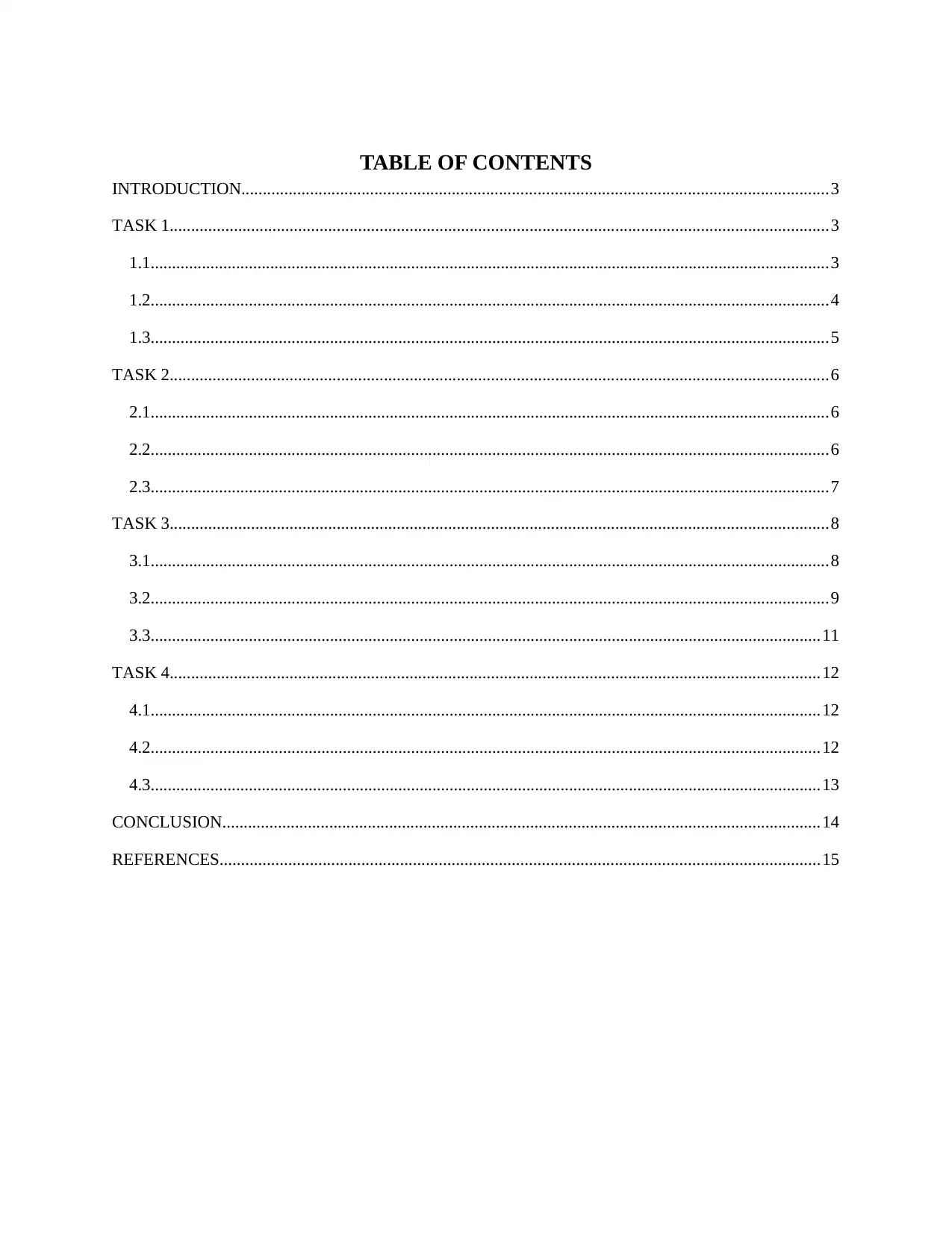
TABLE OF CONTENTS
INTRODUCTION.........................................................................................................................................3
TASK 1..........................................................................................................................................................3
1.1...............................................................................................................................................................3
1.2...............................................................................................................................................................4
1.3...............................................................................................................................................................5
TASK 2..........................................................................................................................................................6
2.1...............................................................................................................................................................6
2.2...............................................................................................................................................................6
2.3...............................................................................................................................................................7
TASK 3..........................................................................................................................................................8
3.1...............................................................................................................................................................8
3.2...............................................................................................................................................................9
3.3.............................................................................................................................................................11
TASK 4........................................................................................................................................................12
4.1.............................................................................................................................................................12
4.2.............................................................................................................................................................12
4.3.............................................................................................................................................................13
CONCLUSION............................................................................................................................................14
REFERENCES............................................................................................................................................15
INTRODUCTION.........................................................................................................................................3
TASK 1..........................................................................................................................................................3
1.1...............................................................................................................................................................3
1.2...............................................................................................................................................................4
1.3...............................................................................................................................................................5
TASK 2..........................................................................................................................................................6
2.1...............................................................................................................................................................6
2.2...............................................................................................................................................................6
2.3...............................................................................................................................................................7
TASK 3..........................................................................................................................................................8
3.1...............................................................................................................................................................8
3.2...............................................................................................................................................................9
3.3.............................................................................................................................................................11
TASK 4........................................................................................................................................................12
4.1.............................................................................................................................................................12
4.2.............................................................................................................................................................12
4.3.............................................................................................................................................................13
CONCLUSION............................................................................................................................................14
REFERENCES............................................................................................................................................15
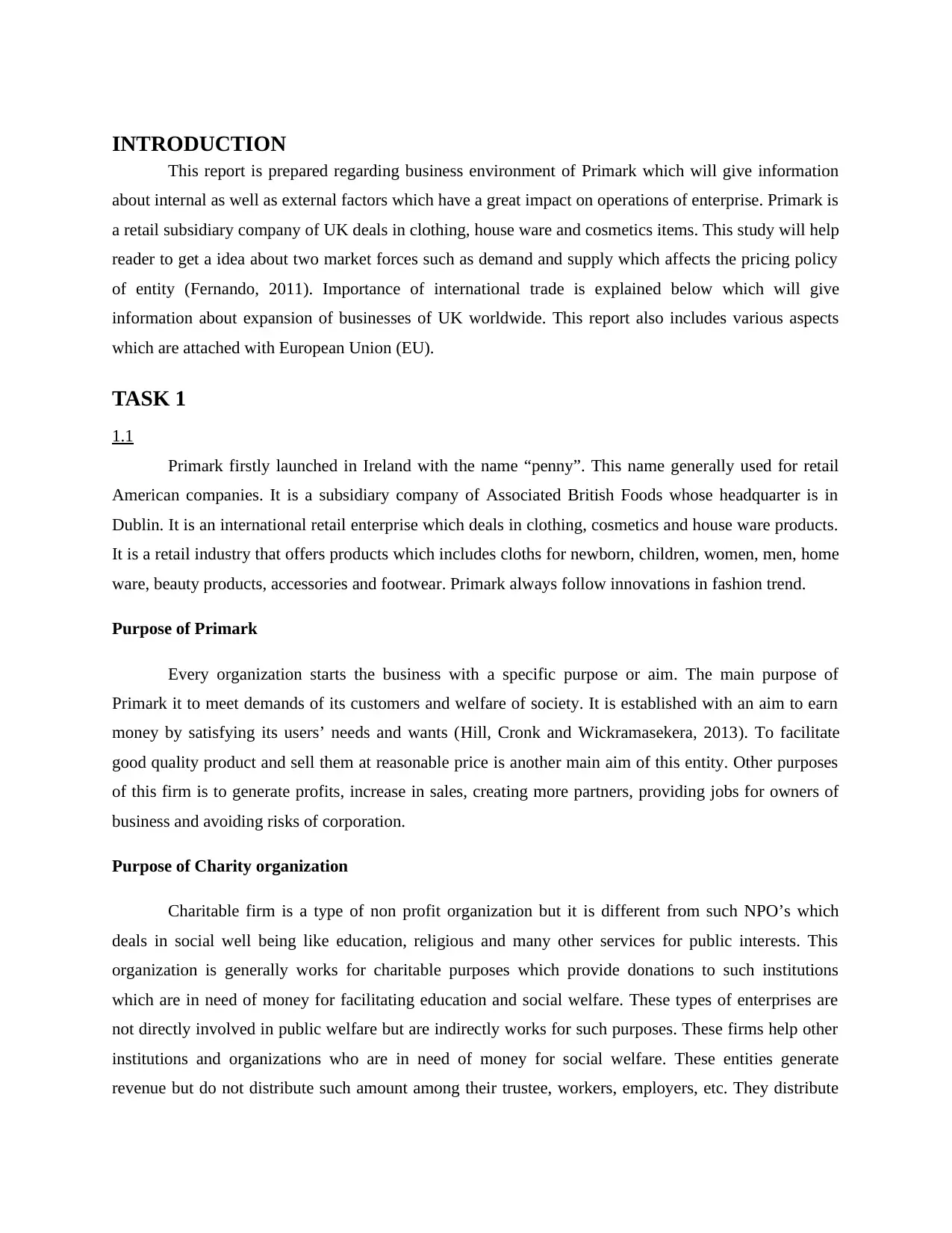
INTRODUCTION
This report is prepared regarding business environment of Primark which will give information
about internal as well as external factors which have a great impact on operations of enterprise. Primark is
a retail subsidiary company of UK deals in clothing, house ware and cosmetics items. This study will help
reader to get a idea about two market forces such as demand and supply which affects the pricing policy
of entity (Fernando, 2011). Importance of international trade is explained below which will give
information about expansion of businesses of UK worldwide. This report also includes various aspects
which are attached with European Union (EU).
TASK 1
1.1
Primark firstly launched in Ireland with the name “penny”. This name generally used for retail
American companies. It is a subsidiary company of Associated British Foods whose headquarter is in
Dublin. It is an international retail enterprise which deals in clothing, cosmetics and house ware products.
It is a retail industry that offers products which includes cloths for newborn, children, women, men, home
ware, beauty products, accessories and footwear. Primark always follow innovations in fashion trend.
Purpose of Primark
Every organization starts the business with a specific purpose or aim. The main purpose of
Primark it to meet demands of its customers and welfare of society. It is established with an aim to earn
money by satisfying its users’ needs and wants (Hill, Cronk and Wickramasekera, 2013). To facilitate
good quality product and sell them at reasonable price is another main aim of this entity. Other purposes
of this firm is to generate profits, increase in sales, creating more partners, providing jobs for owners of
business and avoiding risks of corporation.
Purpose of Charity organization
Charitable firm is a type of non profit organization but it is different from such NPO’s which
deals in social well being like education, religious and many other services for public interests. This
organization is generally works for charitable purposes which provide donations to such institutions
which are in need of money for facilitating education and social welfare. These types of enterprises are
not directly involved in public welfare but are indirectly works for such purposes. These firms help other
institutions and organizations who are in need of money for social welfare. These entities generate
revenue but do not distribute such amount among their trustee, workers, employers, etc. They distribute
This report is prepared regarding business environment of Primark which will give information
about internal as well as external factors which have a great impact on operations of enterprise. Primark is
a retail subsidiary company of UK deals in clothing, house ware and cosmetics items. This study will help
reader to get a idea about two market forces such as demand and supply which affects the pricing policy
of entity (Fernando, 2011). Importance of international trade is explained below which will give
information about expansion of businesses of UK worldwide. This report also includes various aspects
which are attached with European Union (EU).
TASK 1
1.1
Primark firstly launched in Ireland with the name “penny”. This name generally used for retail
American companies. It is a subsidiary company of Associated British Foods whose headquarter is in
Dublin. It is an international retail enterprise which deals in clothing, cosmetics and house ware products.
It is a retail industry that offers products which includes cloths for newborn, children, women, men, home
ware, beauty products, accessories and footwear. Primark always follow innovations in fashion trend.
Purpose of Primark
Every organization starts the business with a specific purpose or aim. The main purpose of
Primark it to meet demands of its customers and welfare of society. It is established with an aim to earn
money by satisfying its users’ needs and wants (Hill, Cronk and Wickramasekera, 2013). To facilitate
good quality product and sell them at reasonable price is another main aim of this entity. Other purposes
of this firm is to generate profits, increase in sales, creating more partners, providing jobs for owners of
business and avoiding risks of corporation.
Purpose of Charity organization
Charitable firm is a type of non profit organization but it is different from such NPO’s which
deals in social well being like education, religious and many other services for public interests. This
organization is generally works for charitable purposes which provide donations to such institutions
which are in need of money for facilitating education and social welfare. These types of enterprises are
not directly involved in public welfare but are indirectly works for such purposes. These firms help other
institutions and organizations who are in need of money for social welfare. These entities generate
revenue but do not distribute such amount among their trustee, workers, employers, etc. They distribute
⊘ This is a preview!⊘
Do you want full access?
Subscribe today to unlock all pages.

Trusted by 1+ million students worldwide
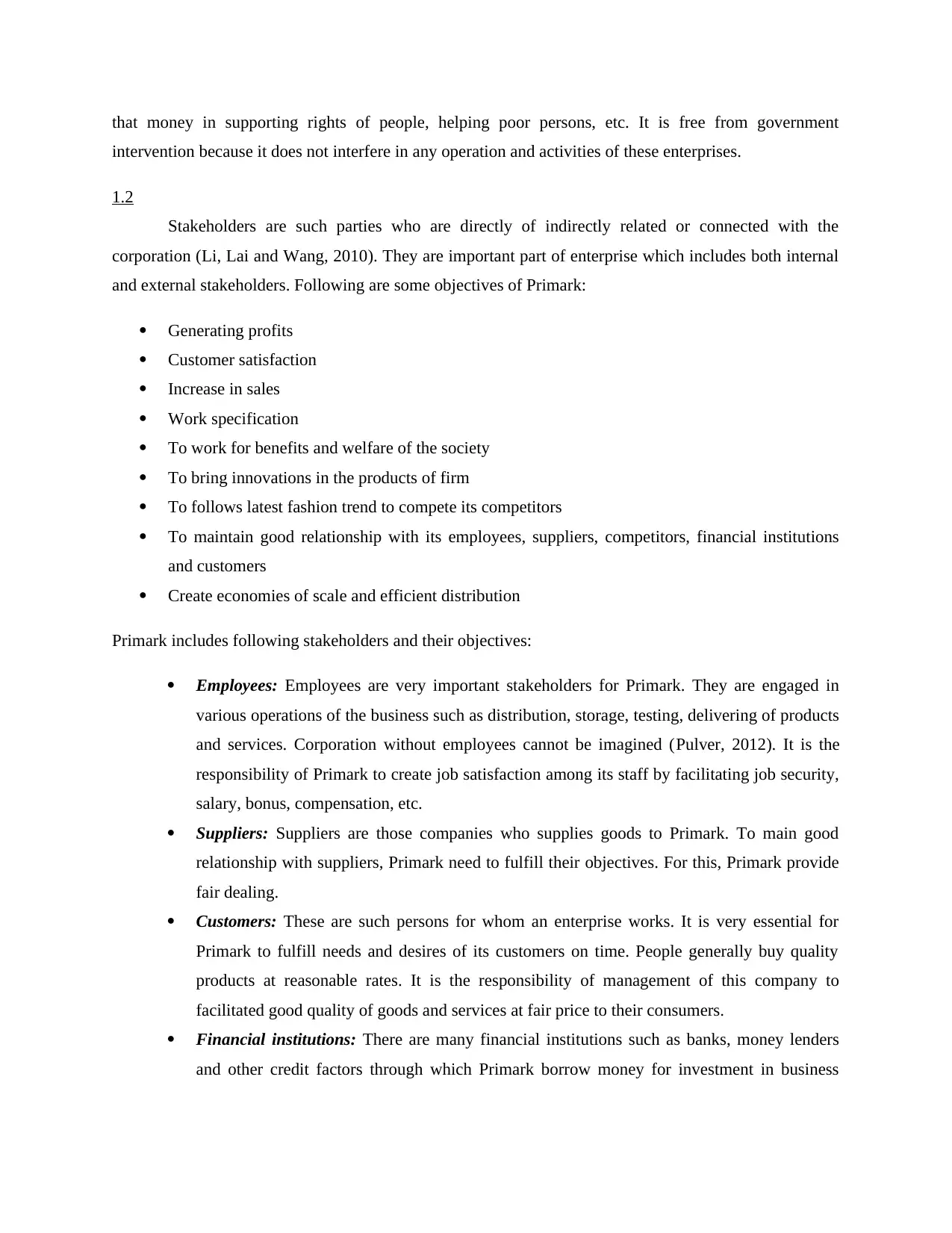
that money in supporting rights of people, helping poor persons, etc. It is free from government
intervention because it does not interfere in any operation and activities of these enterprises.
1.2
Stakeholders are such parties who are directly of indirectly related or connected with the
corporation (Li, Lai and Wang, 2010). They are important part of enterprise which includes both internal
and external stakeholders. Following are some objectives of Primark:
Generating profits
Customer satisfaction
Increase in sales
Work specification
To work for benefits and welfare of the society
To bring innovations in the products of firm
To follows latest fashion trend to compete its competitors
To maintain good relationship with its employees, suppliers, competitors, financial institutions
and customers
Create economies of scale and efficient distribution
Primark includes following stakeholders and their objectives:
Employees: Employees are very important stakeholders for Primark. They are engaged in
various operations of the business such as distribution, storage, testing, delivering of products
and services. Corporation without employees cannot be imagined (Pulver, 2012). It is the
responsibility of Primark to create job satisfaction among its staff by facilitating job security,
salary, bonus, compensation, etc.
Suppliers: Suppliers are those companies who supplies goods to Primark. To main good
relationship with suppliers, Primark need to fulfill their objectives. For this, Primark provide
fair dealing.
Customers: These are such persons for whom an enterprise works. It is very essential for
Primark to fulfill needs and desires of its customers on time. People generally buy quality
products at reasonable rates. It is the responsibility of management of this company to
facilitated good quality of goods and services at fair price to their consumers.
Financial institutions: There are many financial institutions such as banks, money lenders
and other credit factors through which Primark borrow money for investment in business
intervention because it does not interfere in any operation and activities of these enterprises.
1.2
Stakeholders are such parties who are directly of indirectly related or connected with the
corporation (Li, Lai and Wang, 2010). They are important part of enterprise which includes both internal
and external stakeholders. Following are some objectives of Primark:
Generating profits
Customer satisfaction
Increase in sales
Work specification
To work for benefits and welfare of the society
To bring innovations in the products of firm
To follows latest fashion trend to compete its competitors
To maintain good relationship with its employees, suppliers, competitors, financial institutions
and customers
Create economies of scale and efficient distribution
Primark includes following stakeholders and their objectives:
Employees: Employees are very important stakeholders for Primark. They are engaged in
various operations of the business such as distribution, storage, testing, delivering of products
and services. Corporation without employees cannot be imagined (Pulver, 2012). It is the
responsibility of Primark to create job satisfaction among its staff by facilitating job security,
salary, bonus, compensation, etc.
Suppliers: Suppliers are those companies who supplies goods to Primark. To main good
relationship with suppliers, Primark need to fulfill their objectives. For this, Primark provide
fair dealing.
Customers: These are such persons for whom an enterprise works. It is very essential for
Primark to fulfill needs and desires of its customers on time. People generally buy quality
products at reasonable rates. It is the responsibility of management of this company to
facilitated good quality of goods and services at fair price to their consumers.
Financial institutions: There are many financial institutions such as banks, money lenders
and other credit factors through which Primark borrow money for investment in business
Paraphrase This Document
Need a fresh take? Get an instant paraphrase of this document with our AI Paraphraser
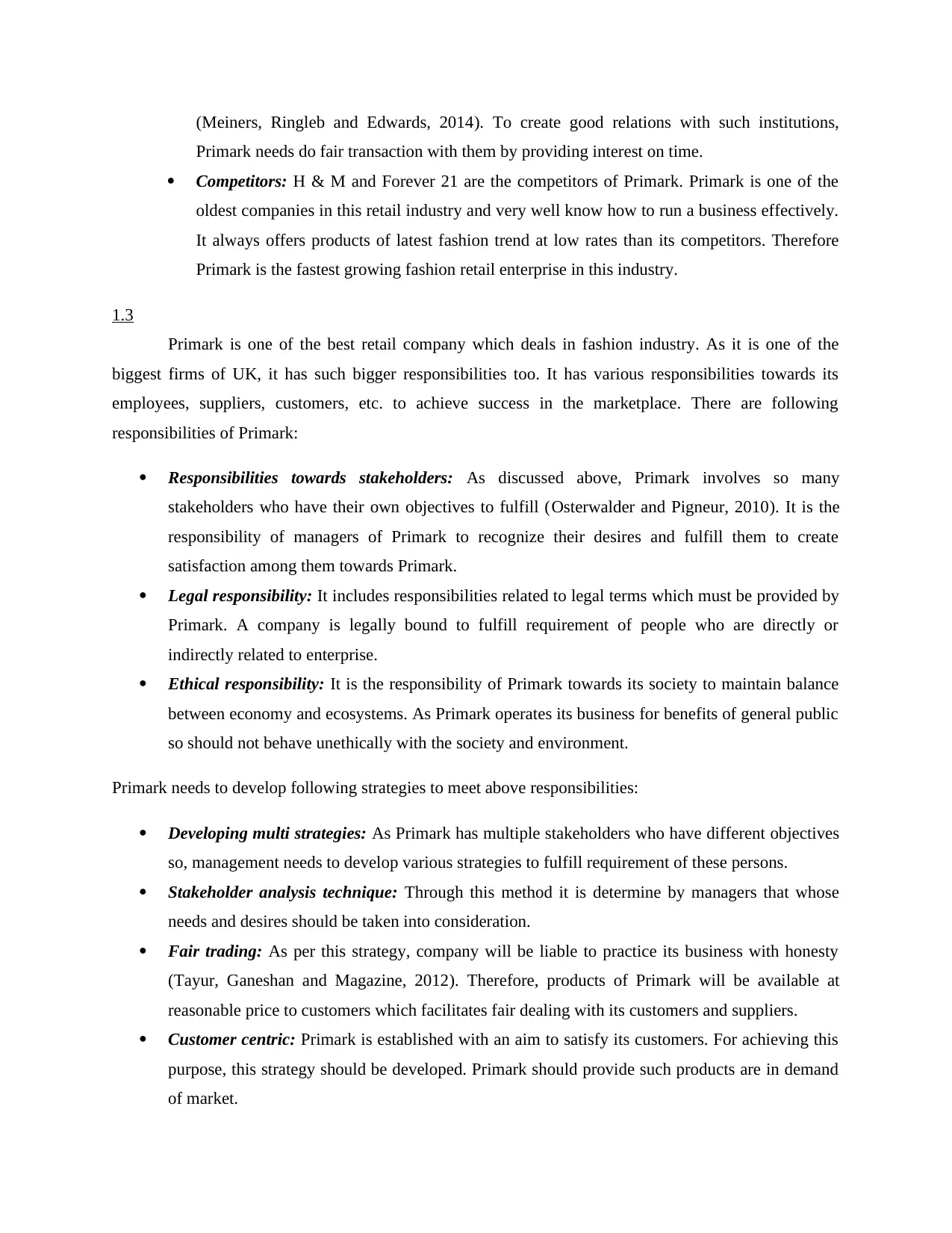
(Meiners, Ringleb and Edwards, 2014). To create good relations with such institutions,
Primark needs do fair transaction with them by providing interest on time.
Competitors: H & M and Forever 21 are the competitors of Primark. Primark is one of the
oldest companies in this retail industry and very well know how to run a business effectively.
It always offers products of latest fashion trend at low rates than its competitors. Therefore
Primark is the fastest growing fashion retail enterprise in this industry.
1.3
Primark is one of the best retail company which deals in fashion industry. As it is one of the
biggest firms of UK, it has such bigger responsibilities too. It has various responsibilities towards its
employees, suppliers, customers, etc. to achieve success in the marketplace. There are following
responsibilities of Primark:
Responsibilities towards stakeholders: As discussed above, Primark involves so many
stakeholders who have their own objectives to fulfill (Osterwalder and Pigneur, 2010). It is the
responsibility of managers of Primark to recognize their desires and fulfill them to create
satisfaction among them towards Primark.
Legal responsibility: It includes responsibilities related to legal terms which must be provided by
Primark. A company is legally bound to fulfill requirement of people who are directly or
indirectly related to enterprise.
Ethical responsibility: It is the responsibility of Primark towards its society to maintain balance
between economy and ecosystems. As Primark operates its business for benefits of general public
so should not behave unethically with the society and environment.
Primark needs to develop following strategies to meet above responsibilities:
Developing multi strategies: As Primark has multiple stakeholders who have different objectives
so, management needs to develop various strategies to fulfill requirement of these persons.
Stakeholder analysis technique: Through this method it is determine by managers that whose
needs and desires should be taken into consideration.
Fair trading: As per this strategy, company will be liable to practice its business with honesty
(Tayur, Ganeshan and Magazine, 2012). Therefore, products of Primark will be available at
reasonable price to customers which facilitates fair dealing with its customers and suppliers.
Customer centric: Primark is established with an aim to satisfy its customers. For achieving this
purpose, this strategy should be developed. Primark should provide such products are in demand
of market.
Primark needs do fair transaction with them by providing interest on time.
Competitors: H & M and Forever 21 are the competitors of Primark. Primark is one of the
oldest companies in this retail industry and very well know how to run a business effectively.
It always offers products of latest fashion trend at low rates than its competitors. Therefore
Primark is the fastest growing fashion retail enterprise in this industry.
1.3
Primark is one of the best retail company which deals in fashion industry. As it is one of the
biggest firms of UK, it has such bigger responsibilities too. It has various responsibilities towards its
employees, suppliers, customers, etc. to achieve success in the marketplace. There are following
responsibilities of Primark:
Responsibilities towards stakeholders: As discussed above, Primark involves so many
stakeholders who have their own objectives to fulfill (Osterwalder and Pigneur, 2010). It is the
responsibility of managers of Primark to recognize their desires and fulfill them to create
satisfaction among them towards Primark.
Legal responsibility: It includes responsibilities related to legal terms which must be provided by
Primark. A company is legally bound to fulfill requirement of people who are directly or
indirectly related to enterprise.
Ethical responsibility: It is the responsibility of Primark towards its society to maintain balance
between economy and ecosystems. As Primark operates its business for benefits of general public
so should not behave unethically with the society and environment.
Primark needs to develop following strategies to meet above responsibilities:
Developing multi strategies: As Primark has multiple stakeholders who have different objectives
so, management needs to develop various strategies to fulfill requirement of these persons.
Stakeholder analysis technique: Through this method it is determine by managers that whose
needs and desires should be taken into consideration.
Fair trading: As per this strategy, company will be liable to practice its business with honesty
(Tayur, Ganeshan and Magazine, 2012). Therefore, products of Primark will be available at
reasonable price to customers which facilitates fair dealing with its customers and suppliers.
Customer centric: Primark is established with an aim to satisfy its customers. For achieving this
purpose, this strategy should be developed. Primark should provide such products are in demand
of market.
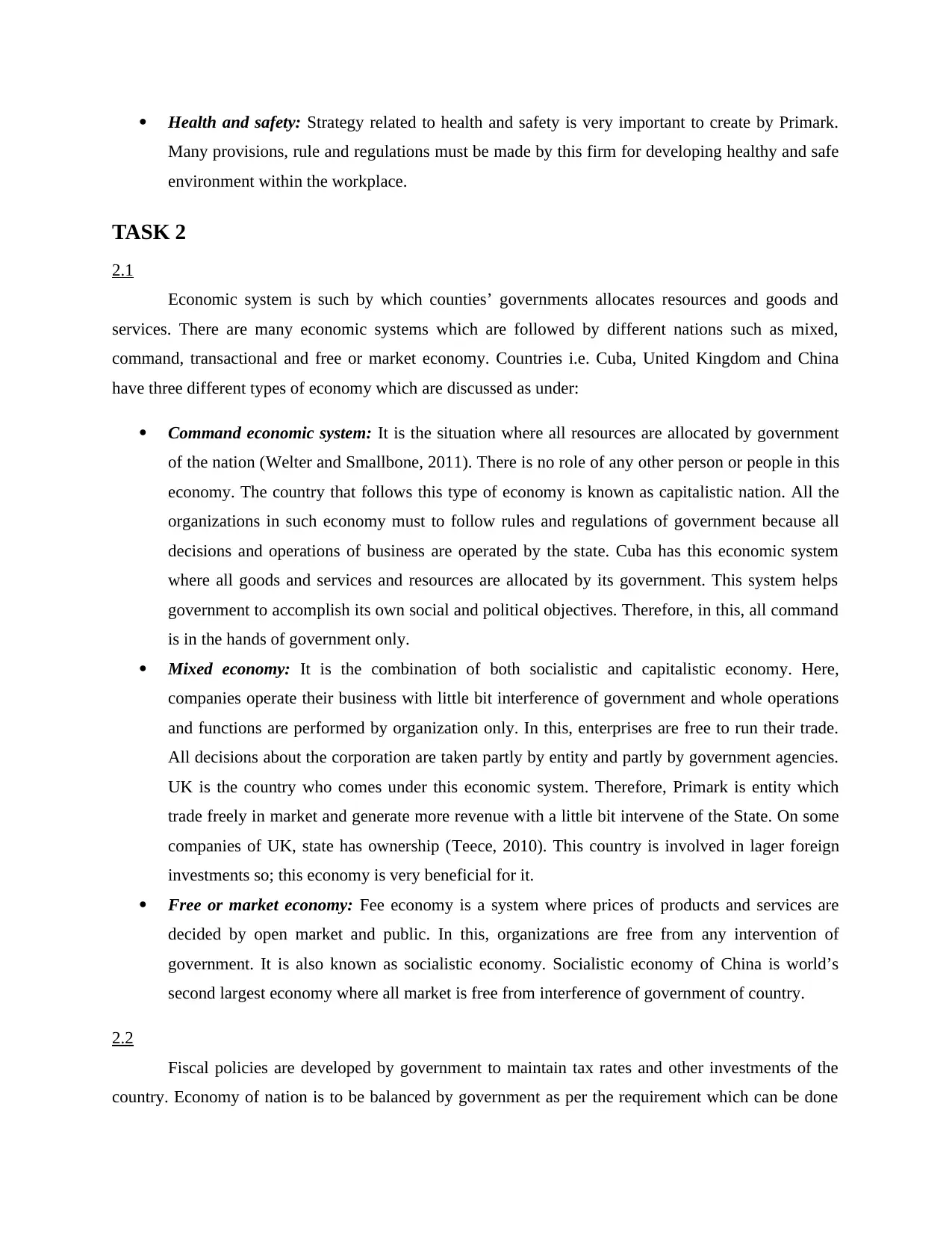
Health and safety: Strategy related to health and safety is very important to create by Primark.
Many provisions, rule and regulations must be made by this firm for developing healthy and safe
environment within the workplace.
TASK 2
2.1
Economic system is such by which counties’ governments allocates resources and goods and
services. There are many economic systems which are followed by different nations such as mixed,
command, transactional and free or market economy. Countries i.e. Cuba, United Kingdom and China
have three different types of economy which are discussed as under:
Command economic system: It is the situation where all resources are allocated by government
of the nation (Welter and Smallbone, 2011). There is no role of any other person or people in this
economy. The country that follows this type of economy is known as capitalistic nation. All the
organizations in such economy must to follow rules and regulations of government because all
decisions and operations of business are operated by the state. Cuba has this economic system
where all goods and services and resources are allocated by its government. This system helps
government to accomplish its own social and political objectives. Therefore, in this, all command
is in the hands of government only.
Mixed economy: It is the combination of both socialistic and capitalistic economy. Here,
companies operate their business with little bit interference of government and whole operations
and functions are performed by organization only. In this, enterprises are free to run their trade.
All decisions about the corporation are taken partly by entity and partly by government agencies.
UK is the country who comes under this economic system. Therefore, Primark is entity which
trade freely in market and generate more revenue with a little bit intervene of the State. On some
companies of UK, state has ownership (Teece, 2010). This country is involved in lager foreign
investments so; this economy is very beneficial for it.
Free or market economy: Fee economy is a system where prices of products and services are
decided by open market and public. In this, organizations are free from any intervention of
government. It is also known as socialistic economy. Socialistic economy of China is world’s
second largest economy where all market is free from interference of government of country.
2.2
Fiscal policies are developed by government to maintain tax rates and other investments of the
country. Economy of nation is to be balanced by government as per the requirement which can be done
Many provisions, rule and regulations must be made by this firm for developing healthy and safe
environment within the workplace.
TASK 2
2.1
Economic system is such by which counties’ governments allocates resources and goods and
services. There are many economic systems which are followed by different nations such as mixed,
command, transactional and free or market economy. Countries i.e. Cuba, United Kingdom and China
have three different types of economy which are discussed as under:
Command economic system: It is the situation where all resources are allocated by government
of the nation (Welter and Smallbone, 2011). There is no role of any other person or people in this
economy. The country that follows this type of economy is known as capitalistic nation. All the
organizations in such economy must to follow rules and regulations of government because all
decisions and operations of business are operated by the state. Cuba has this economic system
where all goods and services and resources are allocated by its government. This system helps
government to accomplish its own social and political objectives. Therefore, in this, all command
is in the hands of government only.
Mixed economy: It is the combination of both socialistic and capitalistic economy. Here,
companies operate their business with little bit interference of government and whole operations
and functions are performed by organization only. In this, enterprises are free to run their trade.
All decisions about the corporation are taken partly by entity and partly by government agencies.
UK is the country who comes under this economic system. Therefore, Primark is entity which
trade freely in market and generate more revenue with a little bit intervene of the State. On some
companies of UK, state has ownership (Teece, 2010). This country is involved in lager foreign
investments so; this economy is very beneficial for it.
Free or market economy: Fee economy is a system where prices of products and services are
decided by open market and public. In this, organizations are free from any intervention of
government. It is also known as socialistic economy. Socialistic economy of China is world’s
second largest economy where all market is free from interference of government of country.
2.2
Fiscal policies are developed by government to maintain tax rates and other investments of the
country. Economy of nation is to be balanced by government as per the requirement which can be done
⊘ This is a preview!⊘
Do you want full access?
Subscribe today to unlock all pages.

Trusted by 1+ million students worldwide
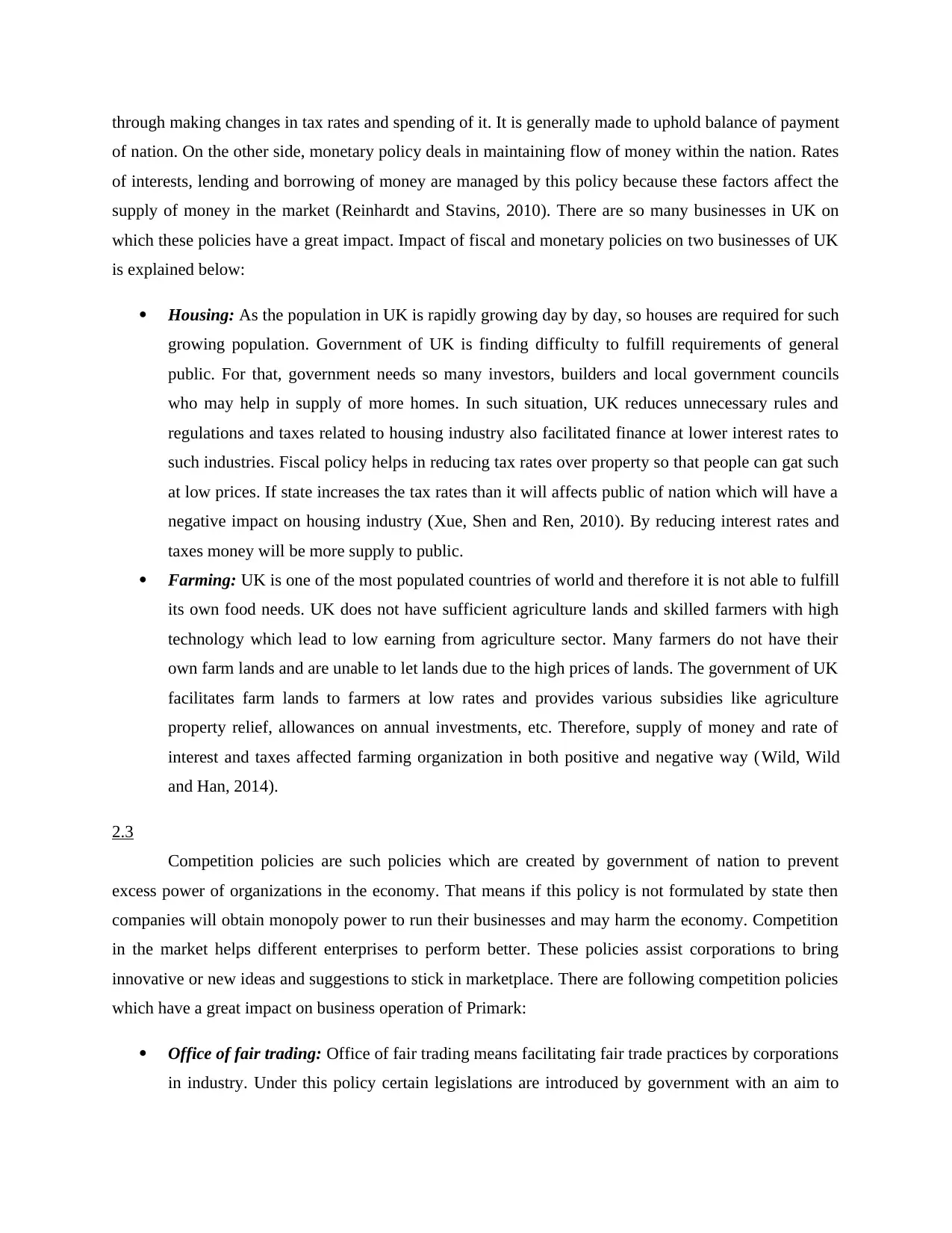
through making changes in tax rates and spending of it. It is generally made to uphold balance of payment
of nation. On the other side, monetary policy deals in maintaining flow of money within the nation. Rates
of interests, lending and borrowing of money are managed by this policy because these factors affect the
supply of money in the market (Reinhardt and Stavins, 2010). There are so many businesses in UK on
which these policies have a great impact. Impact of fiscal and monetary policies on two businesses of UK
is explained below:
Housing: As the population in UK is rapidly growing day by day, so houses are required for such
growing population. Government of UK is finding difficulty to fulfill requirements of general
public. For that, government needs so many investors, builders and local government councils
who may help in supply of more homes. In such situation, UK reduces unnecessary rules and
regulations and taxes related to housing industry also facilitated finance at lower interest rates to
such industries. Fiscal policy helps in reducing tax rates over property so that people can gat such
at low prices. If state increases the tax rates than it will affects public of nation which will have a
negative impact on housing industry (Xue, Shen and Ren, 2010). By reducing interest rates and
taxes money will be more supply to public.
Farming: UK is one of the most populated countries of world and therefore it is not able to fulfill
its own food needs. UK does not have sufficient agriculture lands and skilled farmers with high
technology which lead to low earning from agriculture sector. Many farmers do not have their
own farm lands and are unable to let lands due to the high prices of lands. The government of UK
facilitates farm lands to farmers at low rates and provides various subsidies like agriculture
property relief, allowances on annual investments, etc. Therefore, supply of money and rate of
interest and taxes affected farming organization in both positive and negative way (Wild, Wild
and Han, 2014).
2.3
Competition policies are such policies which are created by government of nation to prevent
excess power of organizations in the economy. That means if this policy is not formulated by state then
companies will obtain monopoly power to run their businesses and may harm the economy. Competition
in the market helps different enterprises to perform better. These policies assist corporations to bring
innovative or new ideas and suggestions to stick in marketplace. There are following competition policies
which have a great impact on business operation of Primark:
Office of fair trading: Office of fair trading means facilitating fair trade practices by corporations
in industry. Under this policy certain legislations are introduced by government with an aim to
of nation. On the other side, monetary policy deals in maintaining flow of money within the nation. Rates
of interests, lending and borrowing of money are managed by this policy because these factors affect the
supply of money in the market (Reinhardt and Stavins, 2010). There are so many businesses in UK on
which these policies have a great impact. Impact of fiscal and monetary policies on two businesses of UK
is explained below:
Housing: As the population in UK is rapidly growing day by day, so houses are required for such
growing population. Government of UK is finding difficulty to fulfill requirements of general
public. For that, government needs so many investors, builders and local government councils
who may help in supply of more homes. In such situation, UK reduces unnecessary rules and
regulations and taxes related to housing industry also facilitated finance at lower interest rates to
such industries. Fiscal policy helps in reducing tax rates over property so that people can gat such
at low prices. If state increases the tax rates than it will affects public of nation which will have a
negative impact on housing industry (Xue, Shen and Ren, 2010). By reducing interest rates and
taxes money will be more supply to public.
Farming: UK is one of the most populated countries of world and therefore it is not able to fulfill
its own food needs. UK does not have sufficient agriculture lands and skilled farmers with high
technology which lead to low earning from agriculture sector. Many farmers do not have their
own farm lands and are unable to let lands due to the high prices of lands. The government of UK
facilitates farm lands to farmers at low rates and provides various subsidies like agriculture
property relief, allowances on annual investments, etc. Therefore, supply of money and rate of
interest and taxes affected farming organization in both positive and negative way (Wild, Wild
and Han, 2014).
2.3
Competition policies are such policies which are created by government of nation to prevent
excess power of organizations in the economy. That means if this policy is not formulated by state then
companies will obtain monopoly power to run their businesses and may harm the economy. Competition
in the market helps different enterprises to perform better. These policies assist corporations to bring
innovative or new ideas and suggestions to stick in marketplace. There are following competition policies
which have a great impact on business operation of Primark:
Office of fair trading: Office of fair trading means facilitating fair trade practices by corporations
in industry. Under this policy certain legislations are introduced by government with an aim to
Paraphrase This Document
Need a fresh take? Get an instant paraphrase of this document with our AI Paraphraser
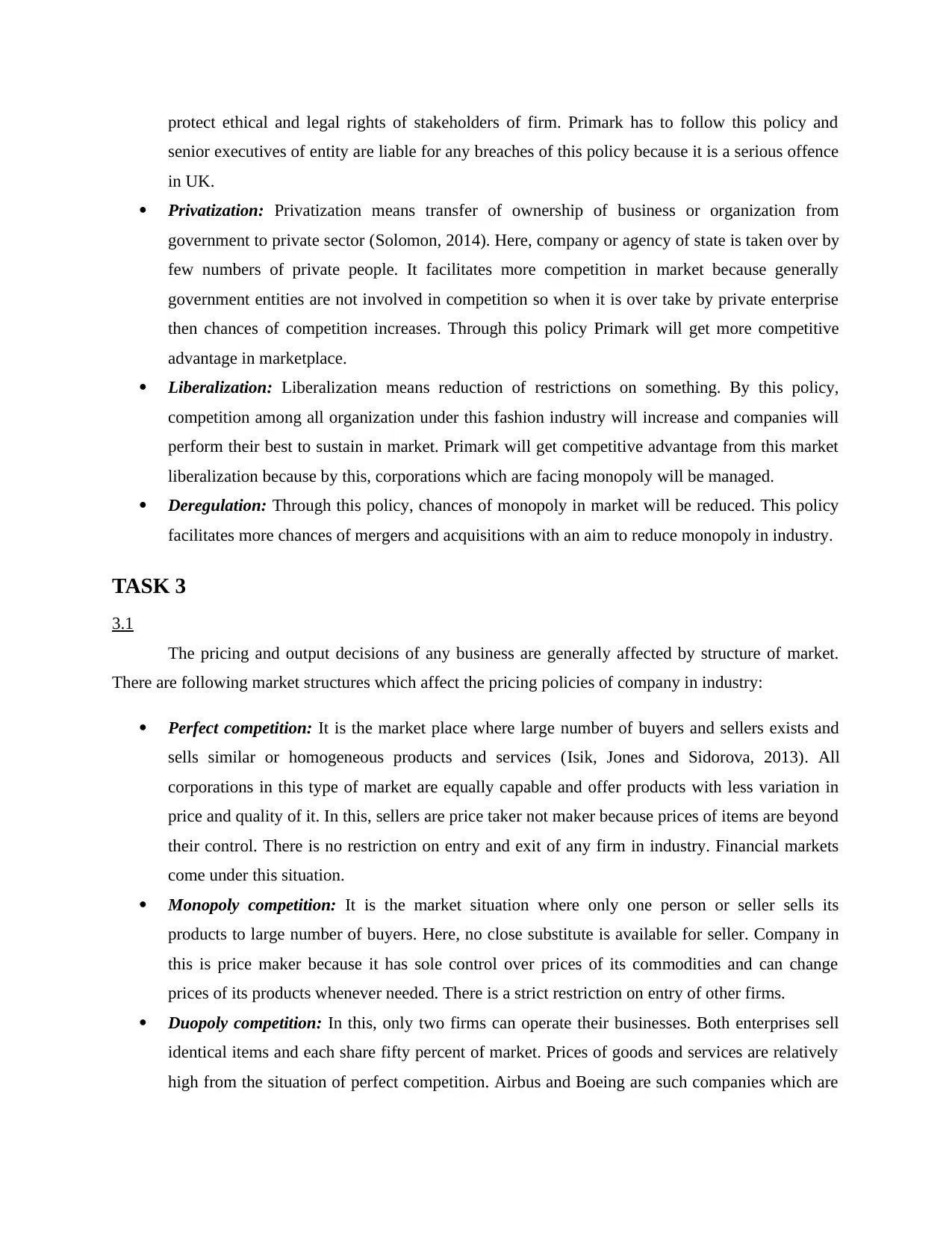
protect ethical and legal rights of stakeholders of firm. Primark has to follow this policy and
senior executives of entity are liable for any breaches of this policy because it is a serious offence
in UK.
Privatization: Privatization means transfer of ownership of business or organization from
government to private sector (Solomon, 2014). Here, company or agency of state is taken over by
few numbers of private people. It facilitates more competition in market because generally
government entities are not involved in competition so when it is over take by private enterprise
then chances of competition increases. Through this policy Primark will get more competitive
advantage in marketplace.
Liberalization: Liberalization means reduction of restrictions on something. By this policy,
competition among all organization under this fashion industry will increase and companies will
perform their best to sustain in market. Primark will get competitive advantage from this market
liberalization because by this, corporations which are facing monopoly will be managed.
Deregulation: Through this policy, chances of monopoly in market will be reduced. This policy
facilitates more chances of mergers and acquisitions with an aim to reduce monopoly in industry.
TASK 3
3.1
The pricing and output decisions of any business are generally affected by structure of market.
There are following market structures which affect the pricing policies of company in industry:
Perfect competition: It is the market place where large number of buyers and sellers exists and
sells similar or homogeneous products and services (Isik, Jones and Sidorova, 2013). All
corporations in this type of market are equally capable and offer products with less variation in
price and quality of it. In this, sellers are price taker not maker because prices of items are beyond
their control. There is no restriction on entry and exit of any firm in industry. Financial markets
come under this situation.
Monopoly competition: It is the market situation where only one person or seller sells its
products to large number of buyers. Here, no close substitute is available for seller. Company in
this is price maker because it has sole control over prices of its commodities and can change
prices of its products whenever needed. There is a strict restriction on entry of other firms.
Duopoly competition: In this, only two firms can operate their businesses. Both enterprises sell
identical items and each share fifty percent of market. Prices of goods and services are relatively
high from the situation of perfect competition. Airbus and Boeing are such companies which are
senior executives of entity are liable for any breaches of this policy because it is a serious offence
in UK.
Privatization: Privatization means transfer of ownership of business or organization from
government to private sector (Solomon, 2014). Here, company or agency of state is taken over by
few numbers of private people. It facilitates more competition in market because generally
government entities are not involved in competition so when it is over take by private enterprise
then chances of competition increases. Through this policy Primark will get more competitive
advantage in marketplace.
Liberalization: Liberalization means reduction of restrictions on something. By this policy,
competition among all organization under this fashion industry will increase and companies will
perform their best to sustain in market. Primark will get competitive advantage from this market
liberalization because by this, corporations which are facing monopoly will be managed.
Deregulation: Through this policy, chances of monopoly in market will be reduced. This policy
facilitates more chances of mergers and acquisitions with an aim to reduce monopoly in industry.
TASK 3
3.1
The pricing and output decisions of any business are generally affected by structure of market.
There are following market structures which affect the pricing policies of company in industry:
Perfect competition: It is the market place where large number of buyers and sellers exists and
sells similar or homogeneous products and services (Isik, Jones and Sidorova, 2013). All
corporations in this type of market are equally capable and offer products with less variation in
price and quality of it. In this, sellers are price taker not maker because prices of items are beyond
their control. There is no restriction on entry and exit of any firm in industry. Financial markets
come under this situation.
Monopoly competition: It is the market situation where only one person or seller sells its
products to large number of buyers. Here, no close substitute is available for seller. Company in
this is price maker because it has sole control over prices of its commodities and can change
prices of its products whenever needed. There is a strict restriction on entry of other firms.
Duopoly competition: In this, only two firms can operate their businesses. Both enterprises sell
identical items and each share fifty percent of market. Prices of goods and services are relatively
high from the situation of perfect competition. Airbus and Boeing are such companies which are
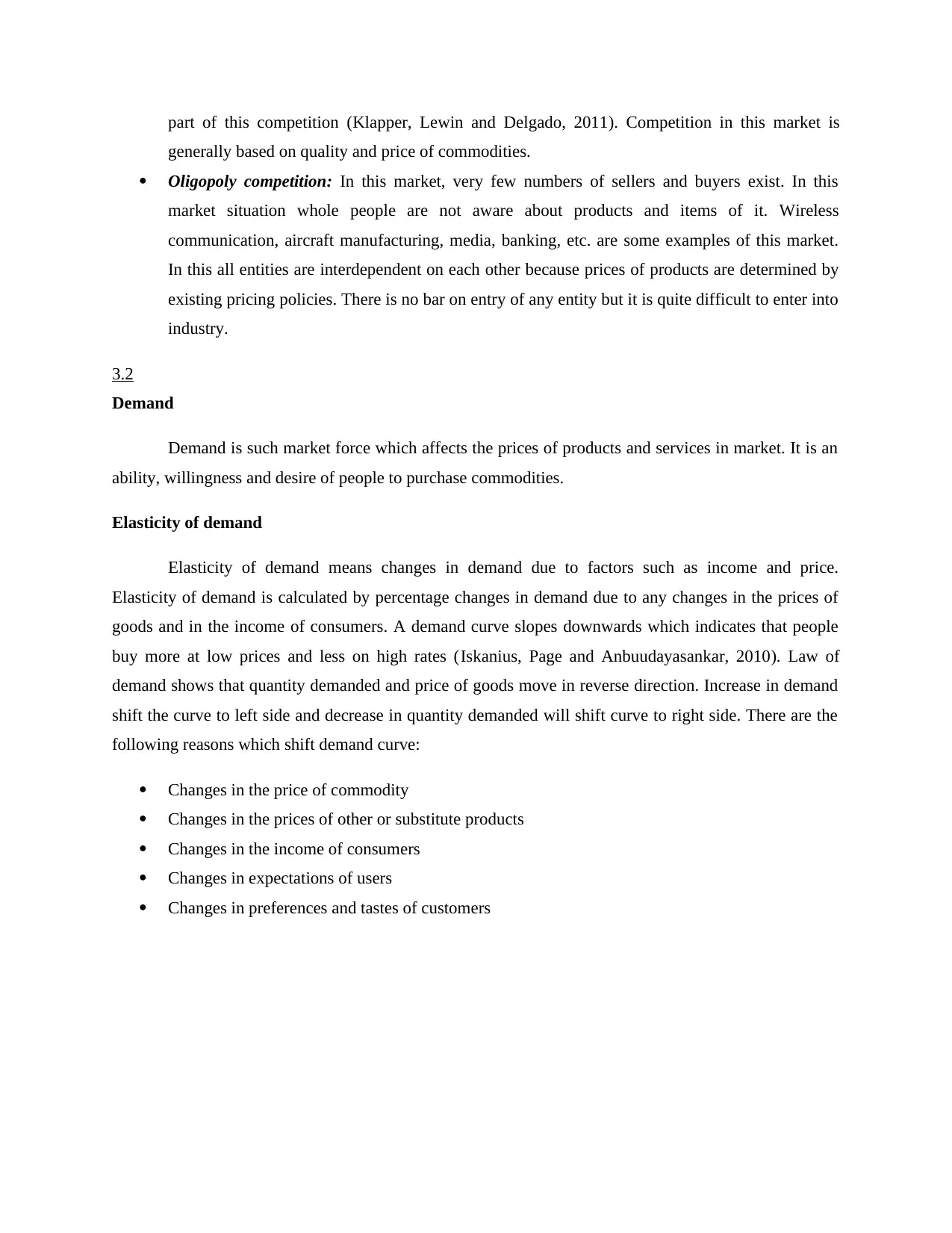
part of this competition (Klapper, Lewin and Delgado, 2011). Competition in this market is
generally based on quality and price of commodities.
Oligopoly competition: In this market, very few numbers of sellers and buyers exist. In this
market situation whole people are not aware about products and items of it. Wireless
communication, aircraft manufacturing, media, banking, etc. are some examples of this market.
In this all entities are interdependent on each other because prices of products are determined by
existing pricing policies. There is no bar on entry of any entity but it is quite difficult to enter into
industry.
3.2
Demand
Demand is such market force which affects the prices of products and services in market. It is an
ability, willingness and desire of people to purchase commodities.
Elasticity of demand
Elasticity of demand means changes in demand due to factors such as income and price.
Elasticity of demand is calculated by percentage changes in demand due to any changes in the prices of
goods and in the income of consumers. A demand curve slopes downwards which indicates that people
buy more at low prices and less on high rates (Iskanius, Page and Anbuudayasankar, 2010). Law of
demand shows that quantity demanded and price of goods move in reverse direction. Increase in demand
shift the curve to left side and decrease in quantity demanded will shift curve to right side. There are the
following reasons which shift demand curve:
Changes in the price of commodity
Changes in the prices of other or substitute products
Changes in the income of consumers
Changes in expectations of users
Changes in preferences and tastes of customers
generally based on quality and price of commodities.
Oligopoly competition: In this market, very few numbers of sellers and buyers exist. In this
market situation whole people are not aware about products and items of it. Wireless
communication, aircraft manufacturing, media, banking, etc. are some examples of this market.
In this all entities are interdependent on each other because prices of products are determined by
existing pricing policies. There is no bar on entry of any entity but it is quite difficult to enter into
industry.
3.2
Demand
Demand is such market force which affects the prices of products and services in market. It is an
ability, willingness and desire of people to purchase commodities.
Elasticity of demand
Elasticity of demand means changes in demand due to factors such as income and price.
Elasticity of demand is calculated by percentage changes in demand due to any changes in the prices of
goods and in the income of consumers. A demand curve slopes downwards which indicates that people
buy more at low prices and less on high rates (Iskanius, Page and Anbuudayasankar, 2010). Law of
demand shows that quantity demanded and price of goods move in reverse direction. Increase in demand
shift the curve to left side and decrease in quantity demanded will shift curve to right side. There are the
following reasons which shift demand curve:
Changes in the price of commodity
Changes in the prices of other or substitute products
Changes in the income of consumers
Changes in expectations of users
Changes in preferences and tastes of customers
⊘ This is a preview!⊘
Do you want full access?
Subscribe today to unlock all pages.

Trusted by 1+ million students worldwide
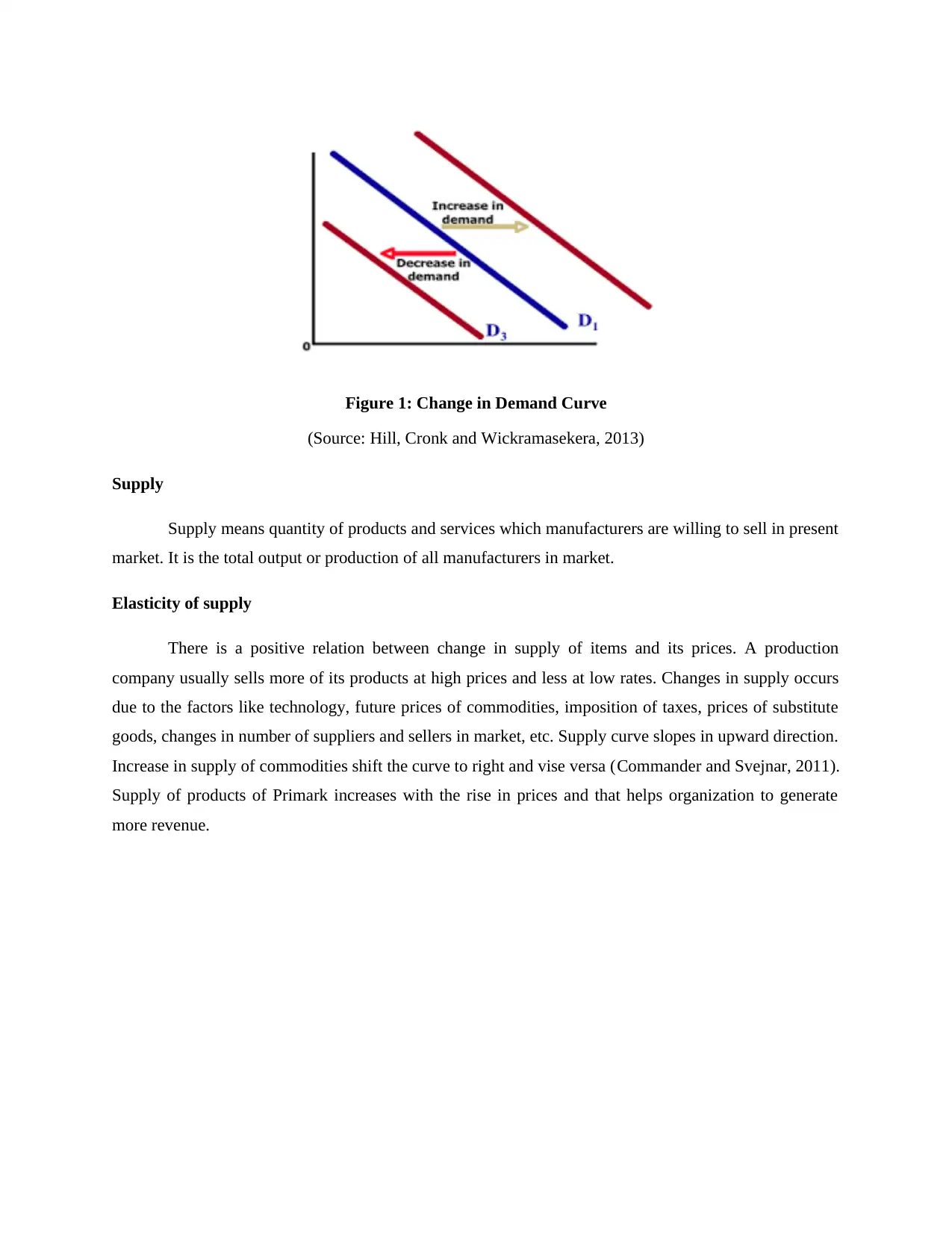
Figure 1: Change in Demand Curve
(Source: Hill, Cronk and Wickramasekera, 2013)
Supply
Supply means quantity of products and services which manufacturers are willing to sell in present
market. It is the total output or production of all manufacturers in market.
Elasticity of supply
There is a positive relation between change in supply of items and its prices. A production
company usually sells more of its products at high prices and less at low rates. Changes in supply occurs
due to the factors like technology, future prices of commodities, imposition of taxes, prices of substitute
goods, changes in number of suppliers and sellers in market, etc. Supply curve slopes in upward direction.
Increase in supply of commodities shift the curve to right and vise versa (Commander and Svejnar, 2011).
Supply of products of Primark increases with the rise in prices and that helps organization to generate
more revenue.
(Source: Hill, Cronk and Wickramasekera, 2013)
Supply
Supply means quantity of products and services which manufacturers are willing to sell in present
market. It is the total output or production of all manufacturers in market.
Elasticity of supply
There is a positive relation between change in supply of items and its prices. A production
company usually sells more of its products at high prices and less at low rates. Changes in supply occurs
due to the factors like technology, future prices of commodities, imposition of taxes, prices of substitute
goods, changes in number of suppliers and sellers in market, etc. Supply curve slopes in upward direction.
Increase in supply of commodities shift the curve to right and vise versa (Commander and Svejnar, 2011).
Supply of products of Primark increases with the rise in prices and that helps organization to generate
more revenue.
Paraphrase This Document
Need a fresh take? Get an instant paraphrase of this document with our AI Paraphraser
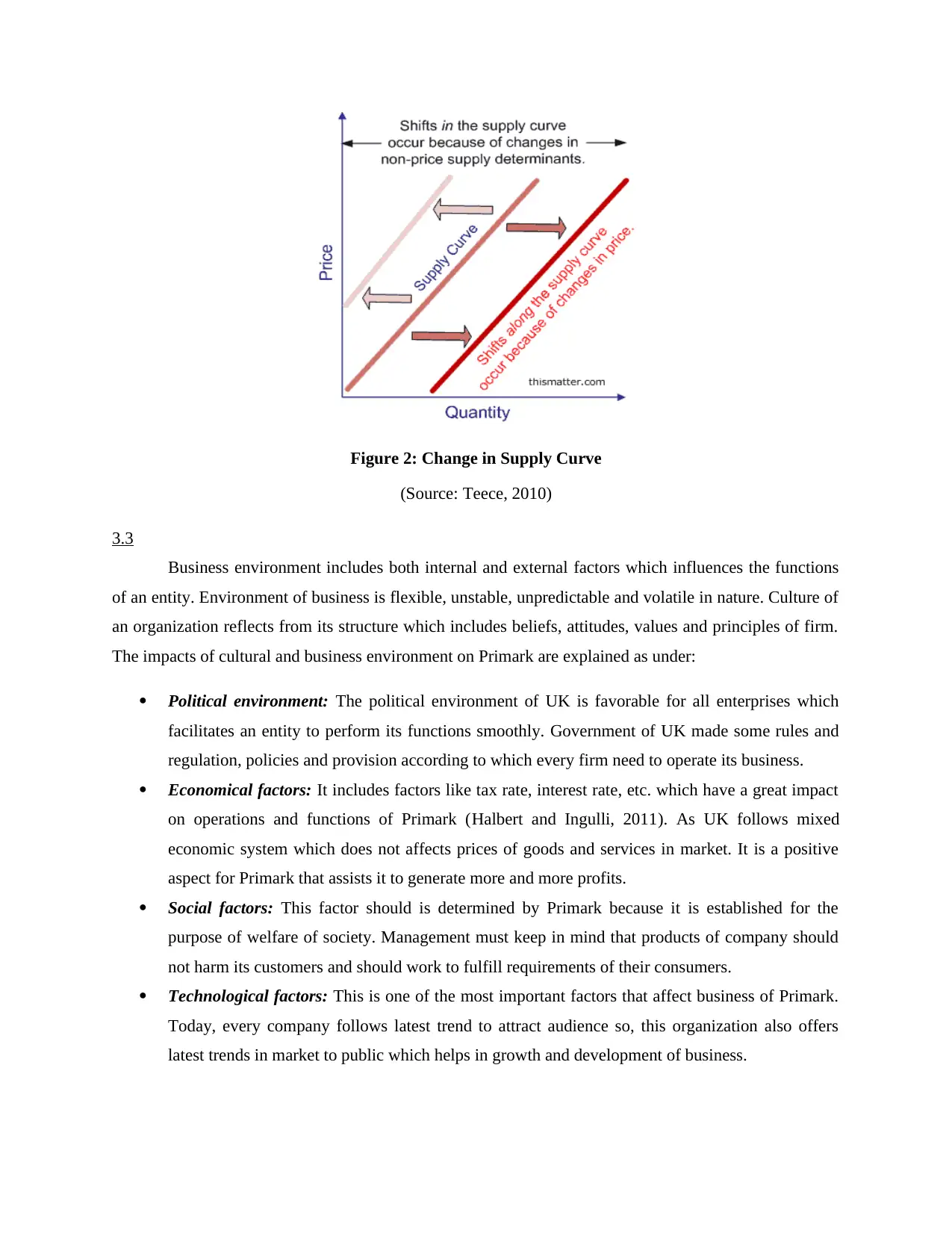
Figure 2: Change in Supply Curve
(Source: Teece, 2010)
3.3
Business environment includes both internal and external factors which influences the functions
of an entity. Environment of business is flexible, unstable, unpredictable and volatile in nature. Culture of
an organization reflects from its structure which includes beliefs, attitudes, values and principles of firm.
The impacts of cultural and business environment on Primark are explained as under:
Political environment: The political environment of UK is favorable for all enterprises which
facilitates an entity to perform its functions smoothly. Government of UK made some rules and
regulation, policies and provision according to which every firm need to operate its business.
Economical factors: It includes factors like tax rate, interest rate, etc. which have a great impact
on operations and functions of Primark (Halbert and Ingulli, 2011). As UK follows mixed
economic system which does not affects prices of goods and services in market. It is a positive
aspect for Primark that assists it to generate more and more profits.
Social factors: This factor should is determined by Primark because it is established for the
purpose of welfare of society. Management must keep in mind that products of company should
not harm its customers and should work to fulfill requirements of their consumers.
Technological factors: This is one of the most important factors that affect business of Primark.
Today, every company follows latest trend to attract audience so, this organization also offers
latest trends in market to public which helps in growth and development of business.
(Source: Teece, 2010)
3.3
Business environment includes both internal and external factors which influences the functions
of an entity. Environment of business is flexible, unstable, unpredictable and volatile in nature. Culture of
an organization reflects from its structure which includes beliefs, attitudes, values and principles of firm.
The impacts of cultural and business environment on Primark are explained as under:
Political environment: The political environment of UK is favorable for all enterprises which
facilitates an entity to perform its functions smoothly. Government of UK made some rules and
regulation, policies and provision according to which every firm need to operate its business.
Economical factors: It includes factors like tax rate, interest rate, etc. which have a great impact
on operations and functions of Primark (Halbert and Ingulli, 2011). As UK follows mixed
economic system which does not affects prices of goods and services in market. It is a positive
aspect for Primark that assists it to generate more and more profits.
Social factors: This factor should is determined by Primark because it is established for the
purpose of welfare of society. Management must keep in mind that products of company should
not harm its customers and should work to fulfill requirements of their consumers.
Technological factors: This is one of the most important factors that affect business of Primark.
Today, every company follows latest trend to attract audience so, this organization also offers
latest trends in market to public which helps in growth and development of business.
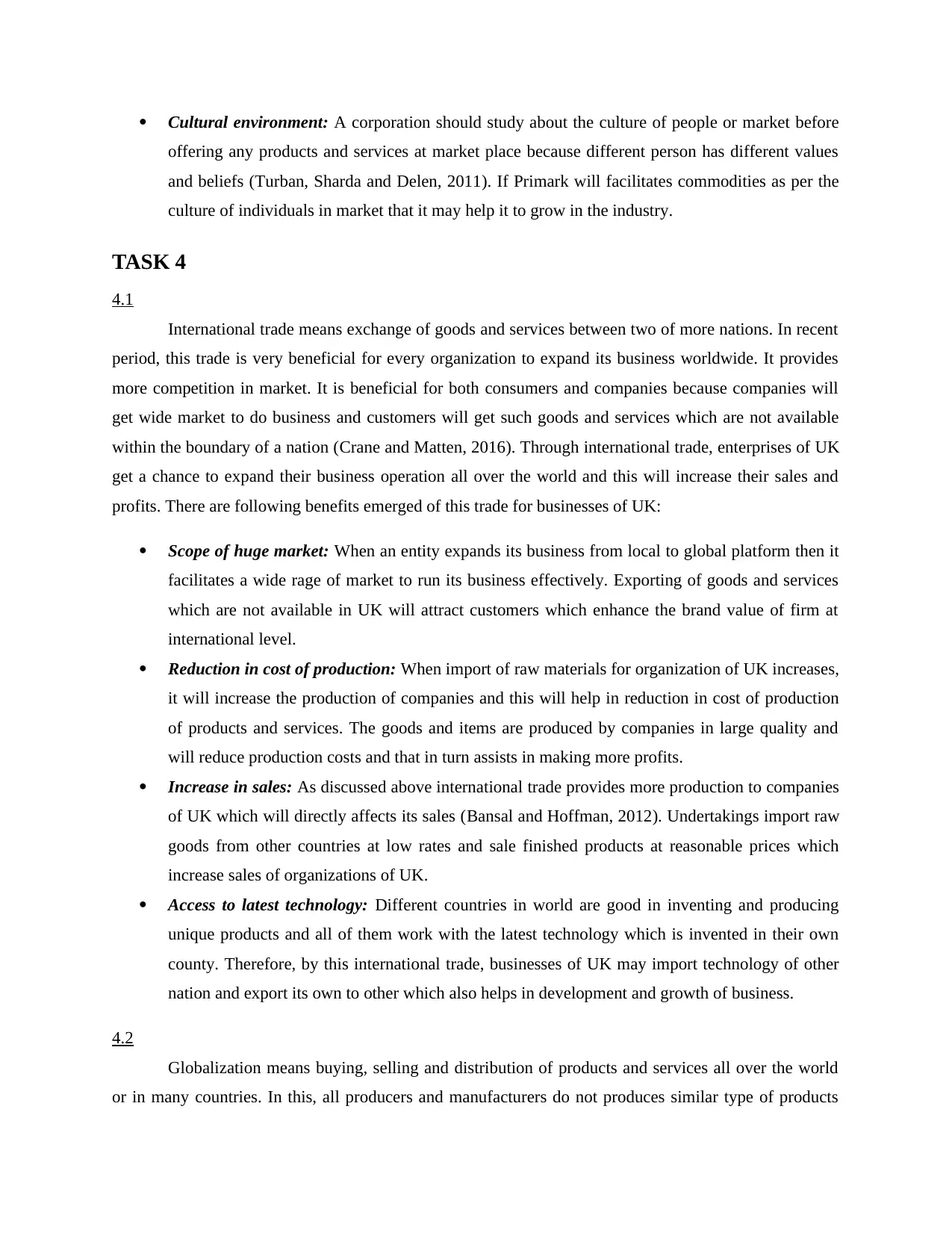
Cultural environment: A corporation should study about the culture of people or market before
offering any products and services at market place because different person has different values
and beliefs (Turban, Sharda and Delen, 2011). If Primark will facilitates commodities as per the
culture of individuals in market that it may help it to grow in the industry.
TASK 4
4.1
International trade means exchange of goods and services between two of more nations. In recent
period, this trade is very beneficial for every organization to expand its business worldwide. It provides
more competition in market. It is beneficial for both consumers and companies because companies will
get wide market to do business and customers will get such goods and services which are not available
within the boundary of a nation (Crane and Matten, 2016). Through international trade, enterprises of UK
get a chance to expand their business operation all over the world and this will increase their sales and
profits. There are following benefits emerged of this trade for businesses of UK:
Scope of huge market: When an entity expands its business from local to global platform then it
facilitates a wide rage of market to run its business effectively. Exporting of goods and services
which are not available in UK will attract customers which enhance the brand value of firm at
international level.
Reduction in cost of production: When import of raw materials for organization of UK increases,
it will increase the production of companies and this will help in reduction in cost of production
of products and services. The goods and items are produced by companies in large quality and
will reduce production costs and that in turn assists in making more profits.
Increase in sales: As discussed above international trade provides more production to companies
of UK which will directly affects its sales (Bansal and Hoffman, 2012). Undertakings import raw
goods from other countries at low rates and sale finished products at reasonable prices which
increase sales of organizations of UK.
Access to latest technology: Different countries in world are good in inventing and producing
unique products and all of them work with the latest technology which is invented in their own
county. Therefore, by this international trade, businesses of UK may import technology of other
nation and export its own to other which also helps in development and growth of business.
4.2
Globalization means buying, selling and distribution of products and services all over the world
or in many countries. In this, all producers and manufacturers do not produces similar type of products
offering any products and services at market place because different person has different values
and beliefs (Turban, Sharda and Delen, 2011). If Primark will facilitates commodities as per the
culture of individuals in market that it may help it to grow in the industry.
TASK 4
4.1
International trade means exchange of goods and services between two of more nations. In recent
period, this trade is very beneficial for every organization to expand its business worldwide. It provides
more competition in market. It is beneficial for both consumers and companies because companies will
get wide market to do business and customers will get such goods and services which are not available
within the boundary of a nation (Crane and Matten, 2016). Through international trade, enterprises of UK
get a chance to expand their business operation all over the world and this will increase their sales and
profits. There are following benefits emerged of this trade for businesses of UK:
Scope of huge market: When an entity expands its business from local to global platform then it
facilitates a wide rage of market to run its business effectively. Exporting of goods and services
which are not available in UK will attract customers which enhance the brand value of firm at
international level.
Reduction in cost of production: When import of raw materials for organization of UK increases,
it will increase the production of companies and this will help in reduction in cost of production
of products and services. The goods and items are produced by companies in large quality and
will reduce production costs and that in turn assists in making more profits.
Increase in sales: As discussed above international trade provides more production to companies
of UK which will directly affects its sales (Bansal and Hoffman, 2012). Undertakings import raw
goods from other countries at low rates and sale finished products at reasonable prices which
increase sales of organizations of UK.
Access to latest technology: Different countries in world are good in inventing and producing
unique products and all of them work with the latest technology which is invented in their own
county. Therefore, by this international trade, businesses of UK may import technology of other
nation and export its own to other which also helps in development and growth of business.
4.2
Globalization means buying, selling and distribution of products and services all over the world
or in many countries. In this, all producers and manufacturers do not produces similar type of products
⊘ This is a preview!⊘
Do you want full access?
Subscribe today to unlock all pages.

Trusted by 1+ million students worldwide
1 out of 16
Related Documents
Your All-in-One AI-Powered Toolkit for Academic Success.
+13062052269
info@desklib.com
Available 24*7 on WhatsApp / Email
![[object Object]](/_next/static/media/star-bottom.7253800d.svg)
Unlock your academic potential
Copyright © 2020–2025 A2Z Services. All Rights Reserved. Developed and managed by ZUCOL.





